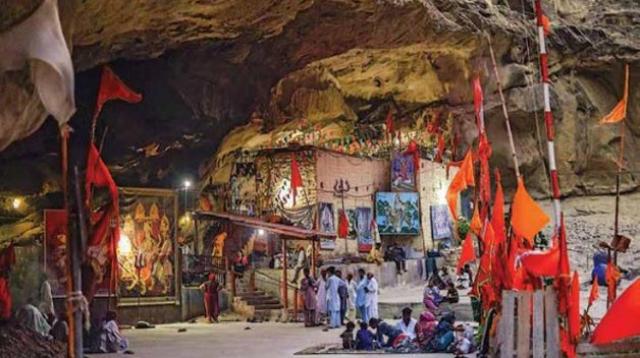Hinglaj Mata Mandir is a famous ‘shakti peetha’ of Goddess Sati. The cave temple is situated on the Hingol River Banks in Hinglaj, a town on the Makran coast in the Lasbela district of Balochistan, Pakistan, and is the middle of the Hingol National Park.
It is also known as ‘Hinglaj Devi‘, ‘Hingula Devi‘ and ‘Nani Mandir‘.

It is about 250 kilometres (160 mi) to the north-west of Karachi, 12 miles (19 km) inland from the Arabian Sea and 80 miles (130 km) to the west of the mouth of the Indus river.
There is no man-made image of the goddess. A small shapeless stone is worshipped as Hinglaj Mata. The stone is smeared with Sindoor (vermilion), which possibly gives the location its Sanskrit name Hingula, which is the root of the present-day name Hinglaj.
Sati’s head fell at this ‘Shakti Peeth‘ which is known as Hinglaj Temple and hence it became a renowned reverential place of Hindus.
The temple is held in high esteem by Hindus and Muslims alike; where Hindus revere it as a ‘Shakti Peeth’ or ‘Devi Mandir’, Muslims call it ‘Nani’ or ‘Bibi Nani’ ka mandir. Every year in April, a four day pilgrimage is organized to the Hinglaj Mandir and several devotees of all religions and faith throng its premises. The deity is also worshipped and visited by many Hindus in India.
Kularnava Tantra mentions 18 Pithas and mentions Hingula as the third one. In the Kubjika Tantra, Hingula is listed among the 42 Shakta or Siddha Pithas in which Hinglaj is at the fifth place.
The Pithanirnaya or Mahapithanirupana section from the Tantrachudamani originally listed 43 names, but names were added over time making it 51 Pithas. It details the Pitha-devata or Devi (name of goddess at the Pitha), the Kshastradishas (Bhairava) and the anga-pratyanga (limbs including ornaments of Sati). Hingula or Hingulata is the first in list, with the anga-pratyanga being Brahmarandhra (a suture in the crown of the head).

The Devi is known by several names such as Kottari, Kottavi, Kottarisha, and the Bhairava is Bhimalochana.
In the Shivasharitha, Hingula is again the first in a list of 55 Pithas. Brahmarandhra is the anga-pratyanga, the goddess is called Kottari and the Bhairava is Bhimalochana (located in Koteshwar, Kutch)
Legends of Hinglaj Mata
There are multiple legends connected to this place and one of them describes story of two princes named Hingol and Sundar, sons of Vichitra from Tatar Mongol Clan, who lived in the Treta yuga .
Their kingdom was close to China and they tormented the people. To free the people from their tyrant, the god Ganesha slew Sundar. Then, the people prayed to Devi to kill Hingol as well, to which she agreed and followed him to the cave, which is currently the Hinglaj Mata shrine.
Before he was killed, Hingol requested the goddess to name the place after him, which she granted.
Another legend is related to the caste Brahmakshatriya, who venerate Hinglaj Mata as their family deity. When the god Parashurama was persecuting kshatriyas (the warrior caste), some Brahmins (priest caste) provided protection to 12 kshatriyas and disguised them as Brahmins and they were also protected by Hinglaj Mata.
This caste traces its roots to the Brahmakshatriyas (Kshatriyas disguised as Brahmins).
Another variation of the tale is that the sage Dadhichi provided protection to Ratnasena, a king of Sindh, in his ashram (hermitage). However, Parashurama killed him when he ventured out.
His sons remained in the ashram. When Parashurama visited the ashram, they were disguised as Brahmins. One of them, Jayasena return to Sindh to rule the kingdom, armed with a protective mantra of Hinglaj Mata, given by Dadhici.
Hinglaj Mata not only protected Jayasena, but also ordered Parshurama to end his killing spree.
Hinglaj mata mandir is very old and has history of being in existence even before Mahabharata times (Dwapara Yuga).
Sindh ruler Jayadratha (Saindhava), brother-in-law of Kauravas built many temples around Hinglaj Mata Mandir.
Pilgrimage of Hinglaj Mata Mandir
Annual pilgrimage starts from Karachi every year in the month of April and people reach here after 4 hours drive.
The local Muslims also hold Hinglaj Mata in reverence and provide security to the shrine. They call the temple as the “Nani Mandir” (lit. “maternal grandmother’s temple”).
The goddess is herself called Bibi Nani (respected maternal grandmother). Bibi Nani may be the same as the goddess Nana, that appears on Kushan coins and was widely worshipped in West and Central Asia.
Local Muslim tribes, following an ancient tradition, also join the pilgrimage group and call the pilgrimage as the “Nani Ki Haj“.
Other places of worship in and around Hinglaj are: Ganesh Deva, Mata Kaali, Gurugorakh Nath Dooni, Braham Kudh, Tir Kundh, Gurunanak Kharao, Ramjarokha Bethak, Aneel Kundh On Chorasi Mountain, Chandra Goop, Khaririver and Aghore Pooja.
There are other Kaali (Goddess) temples in Pakistan, like the Kalka Cave Temple, Arore, near Rohri, Sindh, where mulsims too offer prayer along with hindus.

